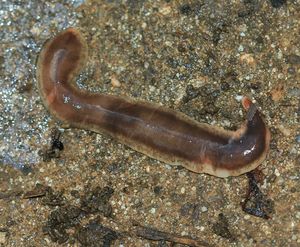New Zealand Flatworm
A. triangulates, also known as the New Zealand flatworm, is a free-living terrestrial flatworm native to New Zealand. This species of flatworm is considered to be an invasive species in several areas of Europe. It is considered an invasive species because of its predation over native earthworms leading to the decline of soil fertility. The leading vector of introduction for this invasive species is thought to be the horticulture and agriculture trade (Blackshaw and Stewart, 1992).

Scientific Classification

Domain: Eukaryota
Kingdom: Metazoa
Phylum: Platyhelminthes
Class: Turbellaria
Order: Tricladida
Family: Geoplanidae
Genus: Arthurdendyus
Species: Arthurdendyus triangulates
Description
Mature Arthurdendyus triangulates can vary in size from 5 to 20cm based on the extension of the body. It has a flattened body that narrows toward the anterior, with no segmentation [2]. (Data Report). The back or dorsal side of the flatworm is a darker brown color and the underside or ventral part of the flatworm is a pale tan color. The body of the flatworm is covered in a mucus that is sticky to the touch [3] (Willis and Edward 1977). These flatworms can be found on the surface of the soil, under debris and other objects that are in contact with the soil, or found beneath the soil when hunting for food. the species has the ability to survive without food for long durations of time (Christensen & Mather, 1995).
The species can move up to 17 meter per hour utilizing trails previously made by earthworms (Christensen & Mather 1995). They move using circular muscles located beneath the epidermal cells and longitudinal muscles that contract throughout the body.
Reproduction
This species of flatworm is a hermaphrodite where adults reproduce following mutual fertilization [4] (Baird et al., 2005). Following fertilization A. triangulates produces a single egg capsule that starts as a red color before turning black. The capsule itself is shiny, flexible and around 8mm in size containing numerous juvenile flatworms [1]. Studies show that a single flatworm can produce an egg capsule once every 2 weeks[4][5]. (Christensen & Mather, 2001)
Native range
The native range of Arthurdendyus triangulates is the South Island in New Zealand. Its native ecosystem is the southern beech forest soils. In its native range there is no documented effects on native earthworm populations [1] (Blackshaw & Stewart, 1992). This species of flatworms can also be found in horticulture soils within its native range such as gardens and plant nurseries [6] (Johns et al.,1998).